Life at the edge: benthic communities at the Barents Sea ice edge in
a changing climate (BASICC): a Norwegian-Russian cooperative project
Sabine Cochrane1 and Chris Emblow2
1 Akvaplan-niva, Polar Environmental Centre, Tromsø, Norway
2 Ecological Consultancy Services Limited (EcoServe), Unit B19 KCR
Ind. Est., Kimmage, Dublin 12, Ireland
sc@akvaplan.niva.no
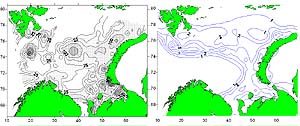 |
Figure 1. Distribution of a) zoobenthos
biomass (g/m2) and b) average monthly duration of the ice edge
(conditions of 20% ice cover in spring/summer) in the Barents Sea.
Data calculated from PINRO zoobenthos survey in 1968-1970 and
Shlitzer (2002), respectively. Figure courtesy of Stanislav
Denisenko, Zoological Institute, St. Petersburg. (Click on image to
enlarge)
Sea-ice is a dominant feature of Arctic ecosystems, which also are
characterised by simplicity in upper trophic layers. However, on the
sea-floor there are complex communities of benthic animals living on or
in the sediment. In some areas, these are extremely high in biomass
and/or numerical abundance.
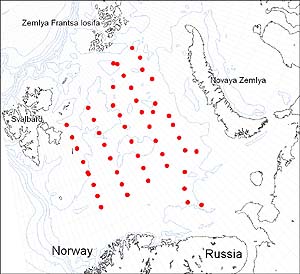 |
Figure 2. The location of sampling stations
in the Barents Sea examined during the BASICC cruise in August 2003.
Benthic organisms rely entirely on sedimented material for food, the
amount, type and availability of which is influenced by many factors
including seasonality, ice-cover, grazing by plankton and bottom
currents. At the ice-edge, there is a very intense and highly seasonal
surge of primary production (McRoy & Goering 1974; Grossmann &
Gleitz 1997, Hegseth 1997; Makarevich 1998; Zernova et al. 2000).
Although no direct link is as yet proven, patterns in benthic biomass in
the Barents Sea seem to show some relationship with the extent of
ice-coverage (Figure 1).
A working hypothesis may therefore be made that benthic biomass is
significantly affected by ice cover. If this is the case, climate-driven
changes in the extent of ice cover are likely to cause a series of
changes to the sea floor biota and other animals feeding off them,
including fish and certain marine mammals.
Financed by the Research Council of Norway, a joint Russian-Norwegian
expedition to the Barents Sea was carried out in August 2003. A total of
49 stations were sampled (Figure 2). The main objectives were to
investigate the benthic faunal communities and energy flow at the
ice-edge, in seasonally ice-covered areas and in permanently ice-free
areas.
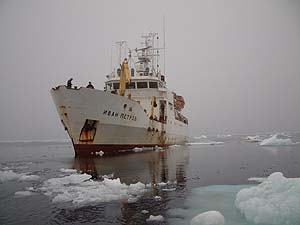 |
The survey vessel RV Ivan Petrov in
the marginal ice zone in the north-eastern Barents Sea.
Quantitative samples of benthic fauna were taken, for analysis of
community composition. An inter-disciplinary approach was used to relate
biological phenomena with physical and chemical characteristics of the
sediments and overlying water masses. In addition, core samples were
taken for analysis of sedimentation rates and bioturbation.
To trace the relative influence of food arising from ice-algae
compared with phytoplankton in open waters, samples were taken of
bottom-living organisms, zooplankton, phytoplankton and ice-bound
material. Using stable isotopes, the aim is to trace and compare
different food sources and to relate this to the composition and biomass
of the benthic faunal communities in the area.
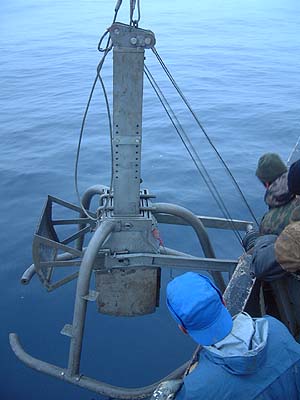 |
A box core was used to take sediment samples
from the seabed. The depth of water ranged between 100 and 450m.
Surface sediment will be analysed for a range of physical and
chemical parameters. Sub-sample cores were taken from the box core
sample for determination of sedimentation rates and bioturbation
depths.
The research vessel used was RV Ivan Petrov, of VNIIOCEANGEOLOGIYA in
Arkhangelsk, Russia. Good working relationships were formed, and our
sincere thanks go to the captain and crew, as well as cruise leader
Boris Vahnstein and his team for unfailing and ever-smiling
round-the-clock operation of sampling equipment.
Through this project, existing cooperation between institutes were
strengthened and expanded to include new participants. The project runs
until 2005 and will contribute to the 6th Framework Network of
Excellence MARBEF (Marine Biodiversity and Ecosystem Functioning) which
is currently under negotiations with the EU. MARBEF is coordinated by
Prof. Carlo Heip. Through these national and international initiatives,
we hope to promote the importance of Arctic biodiversity as a
significant and unique component of Europe biodiversity and to highlight
the work that is being carried out in this region.
Cruise participants
Norway: Sabine Cochrane (project leader, Akvaplan-niva,
Tromsø), Chris Emblow (EcoServe Ltd., Dublin), Kanchan Maiti
(University of South Carolina) and Håvard Dahle (University of Oslo).
Russia: Stanislav Denisenko (Russian coordinator), Slava
Potin, Andrey Voronkov (all Zoological Institute, St. Petersburg) and
Alexander Frolov (Murmansk Marine Biological Institute).
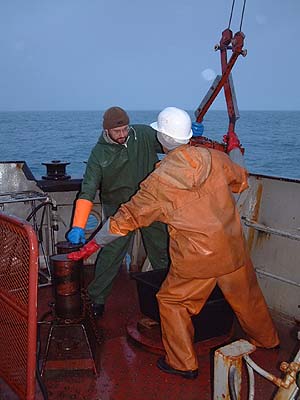 |
A modified van Veen grab was used for
sampling the benthic fauna. Five replicate samples were taken at
each of the 49 stations.
Participating institutes
Akvaplan-niva (Michael Carroll, Salve Dahle), Bates College, USA
(Will Ambrose), University of Troms (Paul Wassman) and the Norwegian
Polar Institute (Stig Falk-Petersen).
References
Grossman S., Gleitz M. 1997. Primary and
microheterotrophic productivity within ice-associated habitats. Ber.Polarforschung
226:73-79.
Hegseth E.N. 1997. Phytoplankton of the Barents Sea
- the end of growth season. Polar Biol. 17:235-241.
Makarevich P.R. 1998. The vernal state or the
microphytoplankton community in the ice-covered areas of the
south-eastern Barents and the south-western Kara seas. In: Biology and
oceanography of the Kara and Barents Seas (along the Northern Marine
route). Apatity, KSC RAS. P.138-149.
McRoy C.P., Goering J.J. 1974. The influence of ice
on the primary productivity of the Bering Sea. In: Oceanography of
the Bering Sea with emphasis on renewable resources. Proc. Int.
symp., Fairbanks, Inst. Mar. Sc. Univ. Alaska. P. 403-421.
Schlitzer R., Ocean Data View, http://www.awi-bremerhaven.de/GEO/ODV,
2002.
Zernova V.V., Nothig E.M., Shevchenko V.P. 2000.
Vertical microalgal flux in the northern Laptev Sea (from data collected
by a yearlong sediment trap). Oceanology 40(6):801-808.
|
